TransX - The cruise function
The cruise function has a whole new set of variables and views.
These are designed to help you to do course corrections and to aim accurately at
the target.
Views
There are three views in this mode, and some of them are not
always available.
Major view - This shows your current orbit, and also any
hypothetical orbit, target body orbit or minor body orbit that may be set. It
also shows an estimate for your closest approach to the target.
Encounter view - This only shows if you have a target set, and
your current trajectory is close enough to that target to pass within its sphere
of influence. It shows TransX's best estimate of how you will pass this body. It
also shows any surface base you may have selected on the surface using the Map
MFD. Like all these estimates, it will wander a bit at first, but becomes
increasingly accurate as you approach the planet.
Course correction view. - This shows a target with some
crosshairs. Aim your ship to put the crosshairs in the centre of the target, and
burn. This view will help you burn off any larger course corrections with
precision.
Cruise function variables
Major view variables
-
View orbits - This one simply adjusts your view of
things. If you are aiming to go to Mercury, you may prefer to see more of
Mercury's orbit, and less of your current position out by Earth. If that's
the case, pick 'Target', otherwise leave this one as it is.
-
Base orbit - This one is important. The MFD has to
have a baseline to compare any course corrections with. It does this by
taking a snapshot of your orbit when the function starts, or right after you
reset the MFD. You can also update this orbit by pressing the ++ key on this
variable. I tend to use resets myself.
-
Prograde vel. - This is the velocity you plan to add
in your current direction of travel.
-
Eject date - This is the time when you plan to do the
actual manoevre. You can put this off into the future if you're in a tight
orbit where it matters exactly when you manoevre. Course corrections in
solar orbit, on the other hand, are not very time critical - if this date is
on the right day, it'll be good enough! Resetting the MFD will reset this
date to the current time. This is another good reason for resetting before a
course correction.
-
Outward vel. - This is the velocity you plan to add
at 90' to your current direction of travel in a broadly outward direction.
-
Ch. plane vel - This is the velocity you plan to add
at 90' to the plane of your orbit. This (obviously) will change your orbital
plane.
-
Projection - Your viewing angle. There are only two
options at the moment, the ecliptic plane, and your craft.
-
Intercept with - This controls which way the
targeting mechanism is set. If it's set to 'craft', it will work off your
actual orbit. If it's set to 'hypothetical' it will work off the orbit you
define using variables. Note the default is 'craft' in this function, but
'hypothetical' in the eject and orbit eject functions.
Encounter view variables
You can use these facilities to completely change your orbit if
you wish - even setting up things like lunar transfers from low earth orbit. But
the most common use is to add the little course corrections needed to reach a
planet.
Making a course correction
There are two schools of thought when it comes to course
corrections. One is to set the whole thing up using a planned burn with
calculated consequences, and then carry out the burn with precision. The other
school of thought - which is particularly appealing for small corrections - is
to just do it. If the adjustment is tiny, fuel efficiency doesn't matter much,
and the immediacy of the feedback you get makes it worthwhile. I tend to do
these tiny adjustments using linear thrusters in bursts of only a couple of
seconds at the most.
Using the variables
First of all, it's good t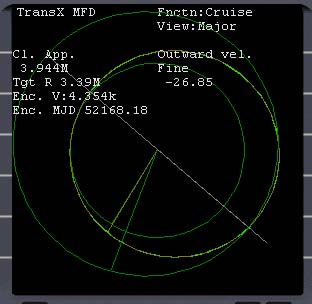 o
wait a while until you're well clear of the planet you started from. Its
gravity causes changes to your orbit for a fair while. But eventually the
figures will settle down. Once you decide to make a course correction
using variables, there are a few standard steps to follow o
wait a while until you're well clear of the planet you started from. Its
gravity causes changes to your orbit for a fair while. But eventually the
figures will settle down. Once you decide to make a course correction
using variables, there are a few standard steps to follow
1. Reset the MFD using the RST key (shift-X). This samples
your current orbit, sets the manoevre time to the present, and zeros
everything else.
2. Switch the targeting system over to 'hypothetical'
using the 'Intercept with' variable.
3. Start playing with the three velocity variables,
looking to reduce the closest approach all the time. Try and get it down
to only a few thousand kilometres the first time.
This is my MFD after juggling the closest approch (in
hypothetical mode) down to four thousand kilometres from Mars's core. And
that figure doesn't even take Mars's gravity into account!
|
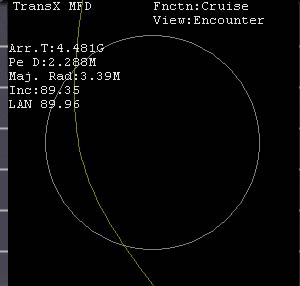 But of
course, you can take Mars's gravity into account as well. To do this,
change the view to Encounter. There you will see how your orbit around
Mars looks. You'll see that your hypothetical orbit is shown there, in
yellow. The MFD reckons that your current path dips to only 2,288
kilometres from the planet's centre. In other words, your current course
correction will put you on a collision course! At this distance, that's
nothing to worry about. But of
course, you can take Mars's gravity into account as well. To do this,
change the view to Encounter. There you will see how your orbit around
Mars looks. You'll see that your hypothetical orbit is shown there, in
yellow. The MFD reckons that your current path dips to only 2,288
kilometres from the planet's centre. In other words, your current course
correction will put you on a collision course! At this distance, that's
nothing to worry about.
As you get closer, the figures here wander less and less, but are still
easy to adjust using tiny course corrections or thruster burns. This way
you can line yourself up as accurately as you like, and use almost no fuel
in the process. |
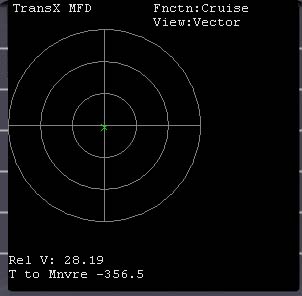 After you're
satisfied with all your variables, switch views again. This time, a target
with some green crosshairs appears. Manoevre your vessel to put the
crosshairs in the centre of the target. After you're
satisfied with all your variables, switch views again. This time, a target
with some green crosshairs appears. Manoevre your vessel to put the
crosshairs in the centre of the target.
You'll also see the size of the burn you've got to do under Rel V. This
was my first course correction burn (which is usually the largest), and
it's about 30 metres per second. For this manoevre , the time doesn't
matter much, which is why it's out by 5 minutes in this case! Burn until
Rel V. is close to zero. |
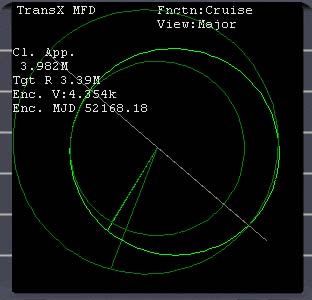 After the
course correction is done, my actual path is now much closer to a Mars
intersection. Do course corrections at regular intervals - especially as
the target comes closer. After the
course correction is done, my actual path is now much closer to a Mars
intersection. Do course corrections at regular intervals - especially as
the target comes closer. |
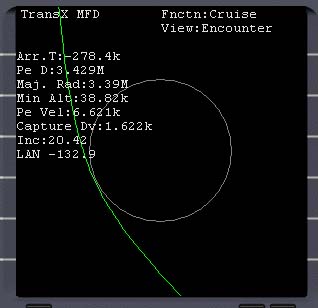 This
screenshot was taken in the Encounter view just over 3 days from closest
approach. The orbit skims close to the surface of Mars. This closeness
makes retro burns more energy and fuel efficient. If you're feeling
braver, you can put your minimum altitude a precise distance from the
surface and aerobrake into orbit! For this type of fine adjustment, it's
best to make regular tiny course corrections with manoevreing thrusters,
and just watch the effect as you make the adjustment. This
screenshot was taken in the Encounter view just over 3 days from closest
approach. The orbit skims close to the surface of Mars. This closeness
makes retro burns more energy and fuel efficient. If you're feeling
braver, you can put your minimum altitude a precise distance from the
surface and aerobrake into orbit! For this type of fine adjustment, it's
best to make regular tiny course corrections with manoevreing thrusters,
and just watch the effect as you make the adjustment.
I chose to make a simple retroburn, and ended up in low Martian orbit
with 24% fuel remaining on board the Deltaglider. That's more than enough
for a good controlled landing! |
Next: Orbit Eject Function
Orbiter Mars - (C) Duncan Sharpe 2003
o
wait a while until you're well clear of the planet you started from. Its
gravity causes changes to your orbit for a fair while. But eventually the
figures will settle down. Once you decide to make a course correction
using variables, there are a few standard steps to follow